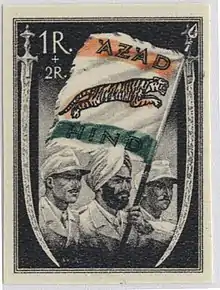Азад Хінд
Тимчасовий уряд вільної Індії (трансліт. Arzi Hukumat-e-Azad Hind, гінді आर्ज़ी हुक़ूमत-ए-आज़ाद हिन्द, урду عارضی حکومتِ آزاد ہند) або просто Вільна Індія (Азад Хінд) — прояпонський «уряд Індії у вигнанні», заснований в Сингапурі в 1943 р.

Історія
Створено індійськими політичними емігрантами-націоналістами для, як вони стверджували, звільнення Індії від британського правління, за фінансової, військової та політичної підтримки Японії[1].
Головою уряду, сформованого 21 жовтня 1943, був проголошений Субхас Чандра Бос.
Азад Хінд випускав свої власні гроші та поштові марки, мав свою судову систему та цивільний кодекс, й індійці сприймали його як законний уряд, що відстоював незалежність Індії[2]. Стяг Азад Хінд використовував індійські національні кольори — помаранчевий, білий і зелений, та зображення стрибаючого тигра.
Після створення Азад Хінд проголосив війну англо-американським союзним військам на індо-бірманському фронті[3]. Були сформовані власні збройні сили, Індійська національна армія, котра вела бойові дії проти англійців (в реальності — проти індусів, що носили британську форму) на ділянці фронту Імпхал-Кохіма.
Після загибелі Боса в авіакатастрофі в 1945 р. уряд припинив своє існування, а Індійська національна армія капітулювала. Одначе солдатів та офіцерів цієї армії в Індії вітали як національних героїв, і британці були змушені амністувати більшість із них[4][5]. Такі провідні діячі колишнього уряду Азад Хінд, як Лакшмі Сахгал та ін., зайняли визначне місце в індійській політиці.
Див. також
- Індійський добровольчий легіон СС «Вільна Індія»
- Індійська національна армія
- Субхас Чандра Бос
- Капітан Лакшмі
Примітки
- Ranjan Borra, «Subhas Chandra Bose, The Indian National Army, and The War of India's Liberation», Journal of Historical Review, 3, no. 4 (Winter 1982), pp. 407—439. available on June 25, 2008 at http://www.ihr.org/jhr/v03/v03p407_Borra.html
After Архівовано 22 лютого 2010 у Wayback Machine. completing the task of reorganizing the Indian Independence League and launching preparations for revolutionizing the army, and after conducting a successful campaign to mobilize the support of the Indian communities throughout Southeast Asia[—]a phase which lasted from July to October[—]Netaji turned toward formation of the Provisional Government of Azad Hind (Free India). This had to be done before the army could be sent for action in the battlefield.
- Borra R., Op. Cit.
- Pandit, HN. Netaji Subhas Chandra Bose’’ Sterling Publishers, New Delhi, 1988, p.331
- Edwardes, Michael, The Last Years of British India, Cleveland, World Pub. Co.,1964, p. 93.
The Government of India had hoped, by prosecuting members of the INA, to reinforce the morale of the Indian army. It succeeded only in creating unease, in making the soldiers feel slightly ashamed that they themselves had supported the British. If Bose and his men had been on the right side — and all India now confirmed that they were — then Indians in the Indian army must have been on the wrong side. It slowly dawned upon the Government of India that the backbone of the British rule, the Indian army, might now no longer be trustworthy. The ghost of Subhas Bose, like Hamlet's father, walked the battlements of the Red Fort (where the INA soldiers were being tried), and his suddenly amplified figure overawed the conference that was to lead to independence.
- Encyclopedia Britannica. Article on Indian National army. After returning to India the veterans of the INA posed a difficult problem for the British government. The British feared that a public trial for treason on the part of the INA members might embolden anti-British sentiment and erupt into widespread protest and violence.http://www.britannica.com/ebi/article-9311795. URL Accessed on 19 Aug 06.
Посилання
- The Last Straw That Broke the Back of the British Empire Архівовано 5 червня 2003 у Wayback Machine.
- Netaji Subhas
- Lecture notes on Bose
